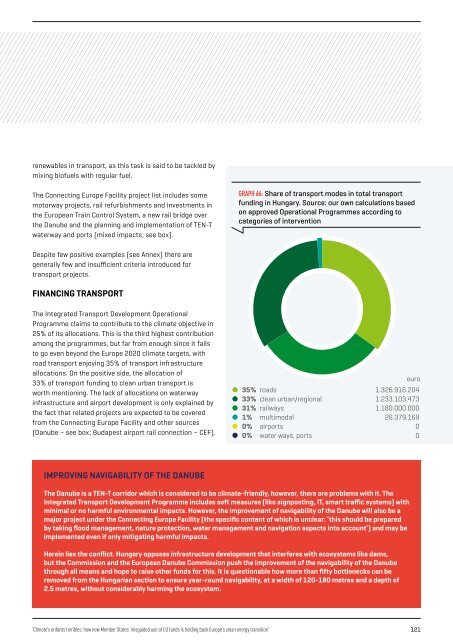ENFANTS TERRIBLES
enfants-terribles
enfants-terribles
You also want an ePaper? Increase the reach of your titles
YUMPU automatically turns print PDFs into web optimized ePapers that Google loves.
enewables in transport, as this task is said to be tackled by<br />
mixing biofuels with regular fuel.<br />
The Connecting Europe Facility project list includes some<br />
motorway projects, rail refurbishments and investments in<br />
the European Train Control System, a new rail bridge over<br />
the Danube and the planning and implementation of TEN-T<br />
waterway and ports (mixed impacts; see box).<br />
GRAPH 66: Share of transport modes in total transport<br />
funding in Hungary. Source: our own calculations based<br />
on approved Operational Programmes according to<br />
categories of intervention<br />
Despite few positive examples (see Annex) there are<br />
generally few and insufficient criteria introduced for<br />
transport projects.<br />
FINANCING TRANSPORT<br />
The Integrated Transport Development Operational<br />
Programme claims to contribute to the climate objective in<br />
25% of its allocations. This is the third highest contribution<br />
among the programmes, but far from enough since it fails<br />
to go even beyond the Europe 2020 climate targets, with<br />
road transport enjoying 35% of transport infrastructure<br />
allocations. On the positive side, the allocation of<br />
33% of transport funding to clean urban transport is<br />
worth mentioning. The lack of allocations on waterway<br />
infrastructure and airport development is only explained by<br />
the fact that related projects are expected to be covered<br />
from the Connecting Europe Facility and other sources<br />
(Danube – see box; Budapest airport rail connection – CEF).<br />
euro<br />
35% roads 1.326.916.204<br />
33% clean urban/regional 1.233.103.473<br />
31% railways 1.180.000.000<br />
1% multimodal 26.379.169<br />
0% airports 0<br />
0% water ways, ports 0<br />
IMPROVING NAVIGABILITY OF THE DANUBE<br />
The Danube is a TEN-T corridor which is considered to be climate-friendly, however, there are problems with it. The<br />
Integrated Transport Development Programme includes soft measures (like signposting, IT, smart traffic systems) with<br />
minimal or no harmful environmental impacts. However, the improvement of navigability of the Danube will also be a<br />
major project under the Connecting Europe Facility (the specific content of which is unclear: ’this should be prepared<br />
by taking flood management, nature protection, water management and navigation aspects into account’) and may be<br />
implemented even if only mitigating harmful impacts.<br />
Herein lies the conflict. Hungary opposes infrastructure development that interferes with ecosystems like dams,<br />
but the Commission and the European Danube Commission push the improvement of the navigability of the Danube<br />
through all means and hope to raise other funds for this. It is questionable how more than fifty bottlenecks can be<br />
removed from the Hungarian section to ensure year-round navigability, at a width of 120-180 metres and a depth of<br />
2.5 metres, without considerably harming the ecosystem.<br />
‘Climate’s enfants terribles: how new Member States’ misguided use of EU funds is holding back Europe’s clean energy transition’ 121


